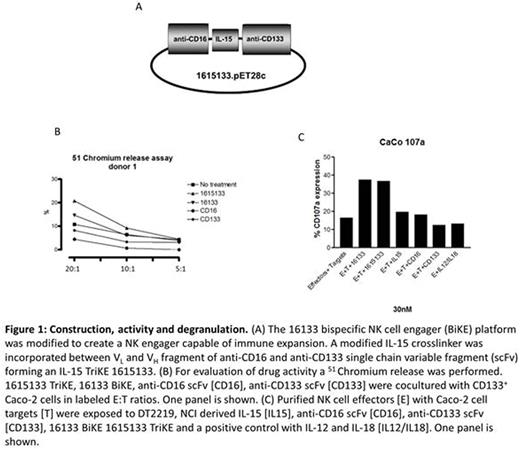Abstract
Background: Selective cancer stem cell (CSC) elimination in solid as well as in and hematologic malignancies is a critical goal in immunotherapy since CSC cause drug refractory relapse. Furthermore this small cell group is known for tumor initiation and self-renewal capabilities and was already described to be a valuable target in breast, head and neck as well as in ovarian cancer. CSCs are also important for the development of hematologic malignancies and might be an excellent cell to target, currently not addressed through current therapies, in order to prevent relapse. The design of state-of-art anti-cancer immune engagers should address three important issues including ADCC, CSC targeting, and rapid effector cell expansion that sustains a potent anti-cancer response. In order to improve the current conventional bispecific immune-engager platform, we synthesized a 16133 BiKE consisting of scFvs binding FcγRIII (CD16) on Natural Killer (NK) cells and CD133 on CSC and then introduced a modified IL-15 crosslinker capable of stimulating NK effector cells.
Methods: DNA shuffling and ligation techniques were used to assemble and synthesize the 1615133 trispecific NK cell engager (TriKE) (Figure 1A). The construct was tested for specificity using flow cytometry, cytotoxicity using chromium release assays, and lytic degranulation. IL-15-mediated expansion was measured using flow based proliferation assays. Also, Interferon (IFN)-γ release was measured by flow cytometry since it is important in the anti-cancer response.
Results: The new TriKE showed specific and efficient induction of NK cell related cytotoxicity as seen in 51chromium release assays with Caco-2 cells, which express high levels of CD133. Activity was superior compared to 16133 BiKE as seen in effector:target ratios of 20:1 (21.9 ± 0.8% vs. 17.9 ± 2.2%), 10:1 (9.4 ± 0.3% vs. 7.9 ± 2.4%) and 5:1 (4.3 ± 0.2% vs. 5.4 ± 1.5%) (Figure 1B). Proliferation and NK expansion with the 1615133 TriKE was far greater than that achieved with the BiKE devoid of IL-15 as tested with purified NK cells exposed to both drugs for 7 days and stained with a reactive dye (Proliferation index 1.7 ± 0.3 vs. 1.2 ± 0.01, p=<0.0001, n=5). Drug binding and induction of cytotoxic degranulation was CD133+ specific as proved with Caco-2 and Raji cells as positive and negative controls (respectively). In Caco-2 cell targets the BiKE as well as the TriKE showed significant superior activity compared to, NCI IL-15, anti-CD16 scFv and anti-CD133 scFv controls (CD107a expression 37.5 ± 0.2% and 36.9 ± 0.2% vs. 19.6 ± 0.1, 18.3 ± 0.7, 12.6 ± 0.4, p<0.001, n=3), (Figure 1C). NK cell related cytokine release measured via IFN-γ detection was higher in the TriKE compared the BiKE (38.3 ± 0.2 % vs. 13.1 ± 0.3 %, p<0.001, n=3) and higher than all other controls. NK cell related cytokine release studies showed that although IFN-γ levels were elevated, they did not approach the levels achieved with IL-12/IL-18 (38.3 ± 0.2 % vs. 60 ± 0.2 %, p<0.001, n=3) indicating that the release induced with the TriKE was not at supraphysiologic levels.
Conclusion: 1615133 TriKE showed specific and improved anti-cancer activity over BiKE and provides a self-sustaining mechanism via induction of IL-15 signaling on NK cells. Inclusion of IL-15 might be a promising platform technology since CD133 can be substituted by other promising tumor associated antigens to create a highly specific and efficient drug. By improving NK cell performance, the new TriKE represents a highly active drug against drug refractory relapse inducing CSC with an encouraging safety profile.
Miller:Oxis Biotech Scientific Advisory Board: Membership on an entity's Board of Directors or advisory committees. Vallera:Oxis Biotech: Consultancy, Membership on an entity's Board of Directors or advisory committees.
Author notes
Asterisk with author names denotes non-ASH members.


This feature is available to Subscribers Only
Sign In or Create an Account Close Modal